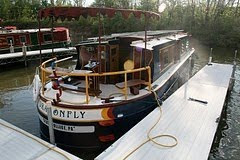 |
| Look Ma, no cooling towers! Calvert Cliffs Nuclear Plant. |
To catch you up on earlier travels: The weather forecast yesterday was grim. "Waves 2 to 5 feet at Chesapeake Beach." But we set out from Solomons anyway, staying close to shore, in the shadow of Calvert Cliffs. And though the wind raged mightily, the water was flat.
The so-called "cliffs" are low, rounded hills that look like layer cakes sliced open. Inside are fossil-laced strata of gold and brown sand.
We made it to Cheseapeake Beach, where, as the sun set, a full moon boomed up over a glittering sea. Leaving the laundromat at 11 PM, I passed a woman in a business suit and sensible shoes, staring at the glowing disc and the bright water below. "Drove all the way from Raleigh just to see this," she murmured.
One of the more interesting sights for us on our 25-mile trip yesterday from Solomons to Chesapeake Beach was the Calvert Cliffs Nuclear Power Plant.
About 3 million people live within 50 miles of this plant, including the residents of Washington DC. Built in the mid 1970s, the plant's two generators use the bay as a heat sink for cooling water.
 |
| And these are the Calvert Cliffs (there are miles more). Layers and layers of sediment laid down 15 million years ago by a shallow Miocene sea. Loaded with fossils, we hear! |
If you live near one, it's probably just part of the landscape to you . . . until something like the current disaster in Japan comes along.
Many of these plants were built in the 1960s and 70s. After Three Mile Island, all of them had new safety measures put in place. All have been upgraded regularly since then. Stuff happens. In 2003, the Calvert Cliffs plant saw an accidental release of a very small amount of radioactive material--a problem traced to an eroded pipe installed 40 years earlier.
According to a recent news story, Calvert Cliffs staff are busy right now re-examining their facility and practices--using Japan as an example, asking, "What if something similar happened here? What would we do in response? What can we do to prevent that?"
One particular concern, according to the website SOMDNews: Tornadoes. Big tornadoes can fling projectiles with enough force to penetrate quite thick layers of concrete and steel.
Saturday night we were hunkered down in our boat in a driving storm, the mere fringe of the storm system that sent those lethal tornadoes through Oklahoma. We were docked a few miles from the Calvert Cliffs nuclear power plant. Makes you think!
A few weeks ago, the NRC launched a review of America's nuclear plants. Excellent plan. Watch for the results in three months.





No comments:
Post a Comment